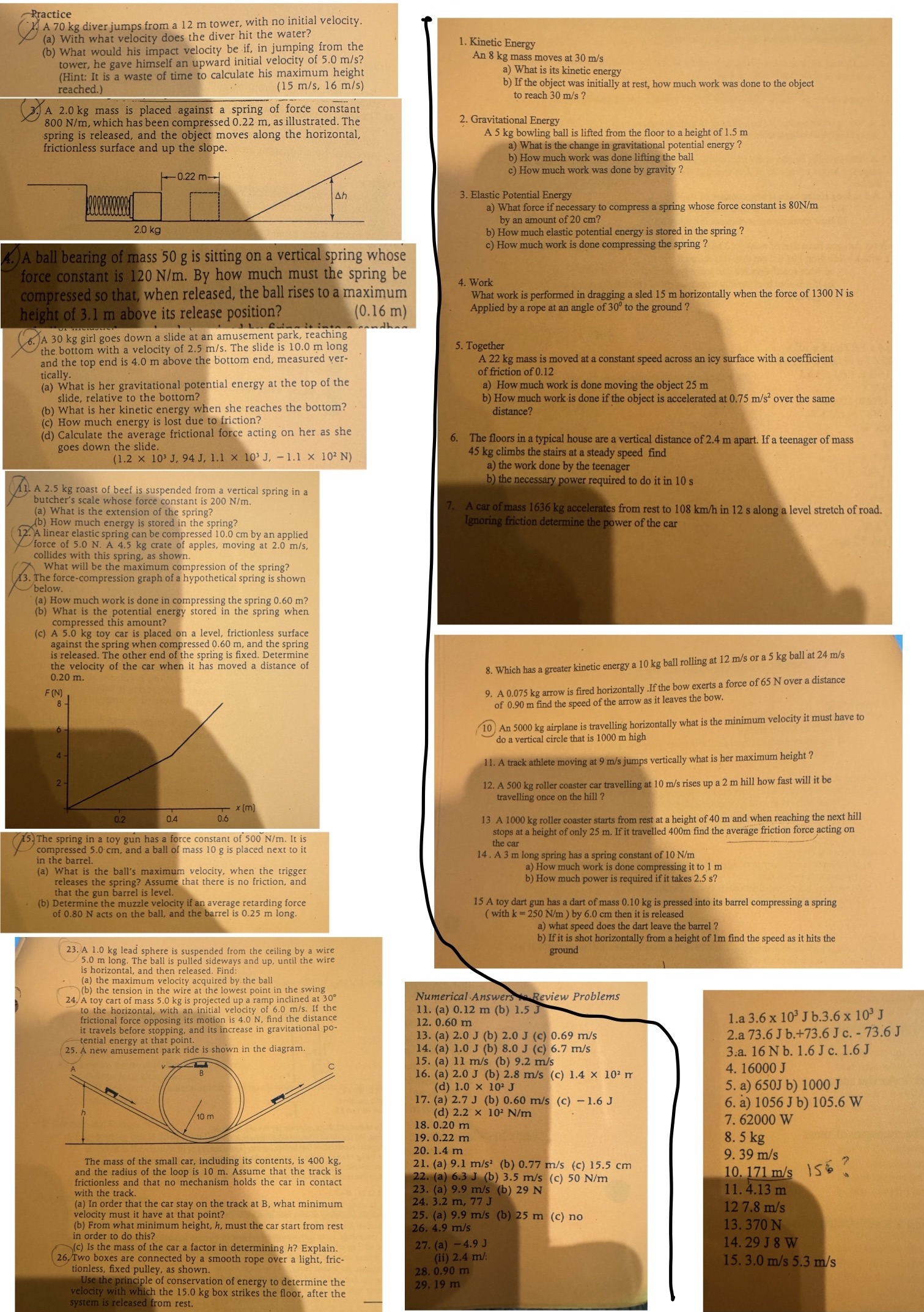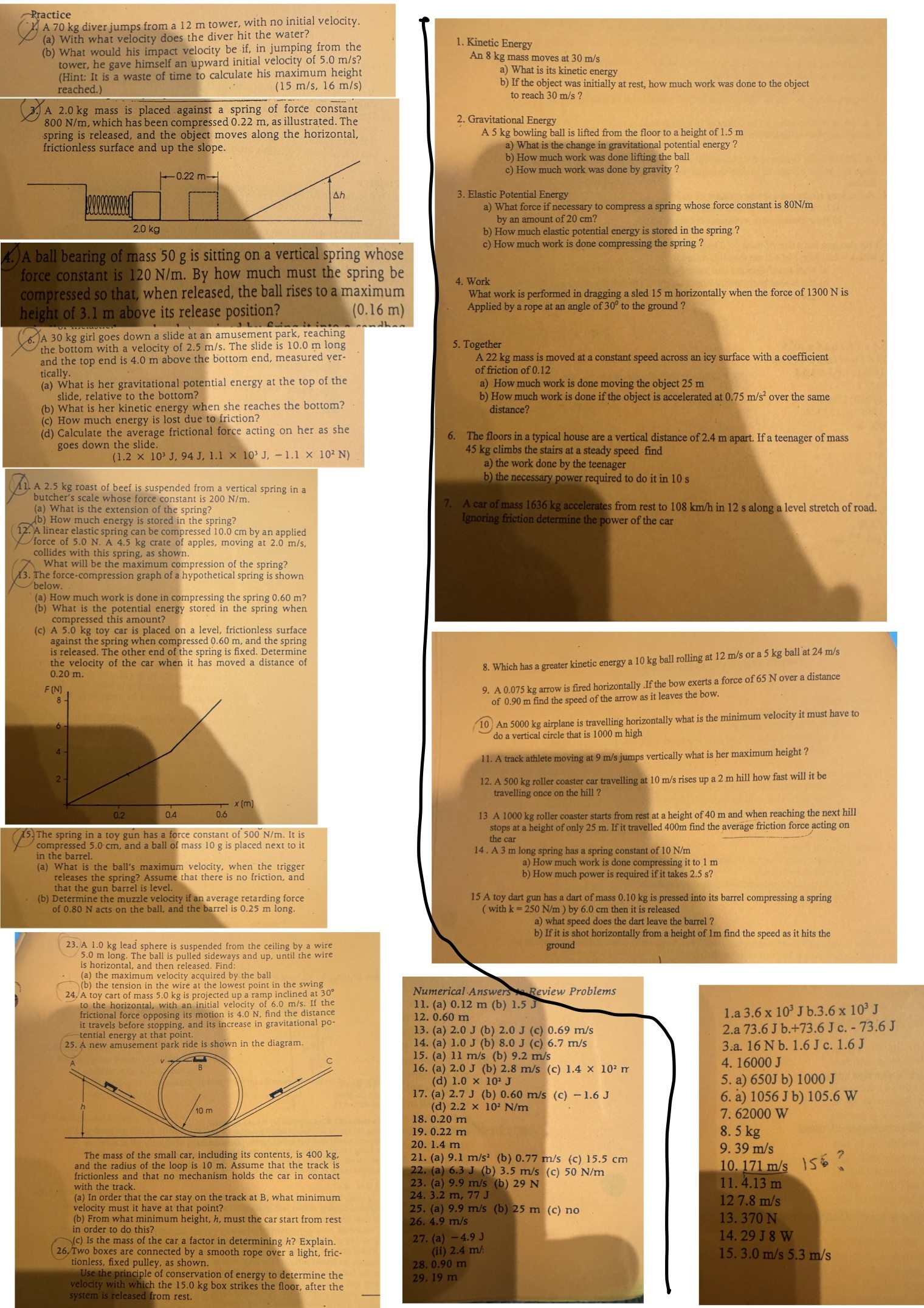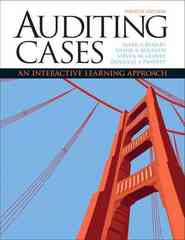Answered step by step
Verified Expert Solution
Question
1 Approved Answer
(Please open this question on desktop to view the photo as it sometimes doesn't show on phones, thanks!) Please solve the following and show the
(Please open this question on desktop to view the photo as it sometimes doesn't show on phones, thanks!) Please solve the following and show the steps of how you solved it. Answers are included at the bottom, thank you!


Practice A 70 kg diver jumps from a 12 m tower, with no initial velocity. (a) With what velocity does the diver hit the water? (b) What would his impact velocity be if, in jumping from the tower, he gave himself an upward initial velocity of 5.0 m/s? (Hint: It is a waste of time to calculate his maximum height reached.) (15 m/s, 16 m/s) A A 2.0 kg mass is placed against a spring of force constant 800 N/m, which has been compressed 0.22 m, as illustrated. The spring is released, and the object moves along the horizontal, frictionless surface and up the slope. 0.22 m- Ah 1. Kinetic Energy An 8 kg mass moves at 30 m/s a) What is its kinetic energy b) If the object was initially at rest, how much work was done to the object to reach 30 m/s ? 2. Gravitational Energy A 5 kg bowling ball is lifted from the floor to a height of 1.5 m a) What is the change in gravitational potential energy? b) How much work was done lifting the ball c) How much work was done by gravity? 3. Elastic Potential Energy a) What force if necessary to compress a spring whose force constant is 80N/m by an amount of 20 cm? b) How much elastic potential energy is stored in the spring? c) How much work is done compressing the spring? 2.0 kg 4. A ball bearing of mass 50 g is sitting on a vertical spring whose force constant is 120 N/m. By how much must the spring be compressed so that, when released, the ball rises to a maximum height of 3.1 m above its release position? B.A A 30 kg girl goes down a slide at an amusement park, reaching the bottom with a velocity of 2.5 m/s. The slide is 10.0 m long and the top end is 4.0 m above the bottom end, measured ver- tically. (a) What is her gravitational potential energy at the top of the slide, relative to the bottom? (b) What is her kinetic energy when she reaches the bottom? (c) How much energy is lost due to friction? (d) Calculate the average frictional force acting on her as she goes down the slide. (1.2 x 10 J, 94 J, 1.1 x 10' J, 1.1 x 102 N) . A 2.5 kg roast of beef is suspended from a vertical spring in a butcher's scale whose force constant is 200 N/m. (a) What is the extension of the spring? (b) How much energy is stored in the spring? 12. A linear elastic spring can be compressed 10.0 cm by an applied force of 5.0 N. A 4.5 kg crate of apples, moving at 2.0 m/s, collides with this spring, as shown. What will be the maximum compression of the spring? 13. The force-compression graph of a hypothetical spring is shown below. (a) How much work is done in compressing the spring 0.60 m? (b) What is the potential energy stored in the spring when compressed this amount? (c) A 5.0 kg toy car is placed on a level, frictionless surface against the spring when compressed 0.60 m, and the spring is released. The other end of the spring is fixed. Determine the velocity of the car when it has moved a distance of 0.20 m. (57 F(N) 8- 4- 0.2 0.4 x (m) 0.6 5. The spring in a toy gun has a force constant of 500 N/m. It is compressed 5.0 cm, and a ball of mass 10 g is placed next to it in the barrel. (a) What is the ball's maximum velocity, when the trigger releases the spring? Assume that there is no friction, and that the gun barrel is level. (b) Determine the muzzle velocity if an average retarding force of 0.80 N acts on the ball, and the barrel is 0.25 m long. 23. A 1.0 kg lead sphere is suspended from the ceiling by a wire 5.0 m long. The ball is pulled sideways and up, until the wire is horizontal, and then released. Find: (a) the maximum velocity acquired by the ball (b) the tension in the wire at the lowest point in the swing 24. A toy cart of mass 5.0 kg is projected up a ramp inclined at 30 to the horizontal, with an initial velocity of 6.0 m/s. If the frictional force opposing its motion is 4.0 N, find the distance it travels before stopping, and its increase in gravitational po- tential energy at that point. 25. A new amusement park ride is shown in the diagram. B 10 m C The mass of the small car, including its contents, is 400 kg, and the radius of the loop is 10 m. Assume that the track is frictionless and that no mechanism holds the car in contact with the track. (a) In order that the car stay on the track at B, what minimum velocity must it have at that point? (b) From what minimum height, h, must the car start from rest in order to do this? (c) Is the mass of the car a factor in determining h? Explain. 26. Two boxes are connected by a smooth rope over a light, fric- tionless, fixed pulley, as shown. Use the principle of conservation of energy to determine the velocity with which the 15.0 kg box strikes the floor, after the system is released from rest. (0.16 m) 4. Work What work is performed in dragging a sled 15 m horizontally when the force of 1300 N is Applied by a rope at an angle of 30 to the ground? 5. Together A 22 kg mass is moved at a constant speed across an icy surface with a coefficient of friction of 0.12 a) How much work is done moving the object 25 m b) How much work is done if the object is accelerated at 0.75 m/s over the same distance? 6. The floors in a typical house are a vertical distance of 2.4 m apart. If a teenager of mass 45 kg climbs the stairs at a steady speed find a) the work done by the teenager b) the necessary power required to do it in 10 s 7. A car of mass 1636 kg accelerates from rest to 108 km/h in 12 s along a level stretch of road. Ignoring friction determine the power of the car 8. Which has a greater kinetic energy a 10 kg ball rolling at 12 m/s or a 5 kg ball at 24 m/s 9. A 0.075 kg arrow is fired horizontally .If the bow exerts a force of 65 N over a distance of 0.90 m find the speed of the arrow as it leaves the bow. 10 An 5000 kg airplane is travelling horizontally what is the minimum velocity it must have to do a vertical circle that is 1000 m high 11. A track athlete moving at 9 m/s jumps vertically what is her maximum height? 12. A 500 kg roller coaster car travelling at 10 m/s rises up a 2 m hill how fast will it be travelling once on the hill? 13 A 1000 kg roller coaster starts from rest at a height of 40 m and when reaching the next hill stops at a height of only 25 m. If it travelled 400m find the average friction force acting on the car 14. A 3 m long spring has a spring constant of 10 N/m a) How much work is done compressing it to 1 m b) How much power is required if it takes 2.5 s? 15 A toy dart gun has a dart of mass 0.10 kg is pressed into its barrel compressing a spring (with k=250 N/m) by 6.0 cm then it is released Numerical Answers a) what speed does the dart leave the barrel? b) If it is shot horizontally from a height of 1m find the speed as it hits the ground Review Problems 11. (a) 0.12 m (b) 1.5 J 12. 0.60 m 13. (a) 2.0 J (b) 2.0 J (c) 0.69 m/s 14. (a) 1.0 J (b) 8.0 J (c) 6.7 m/s 15. (a) 11 m/s (b) 9.2 m/s 16. (a) 2.0 J (b) 2.8 m/s (c) 1.4 x 10 m (d) 1.0 x 102 J 17. (a) 2.7 J (b) 0.60 m/s (c) - 1.6 J (d) 2.2 x 102 N/m 18. 0.20 m 19.0.22 m 20. 1.4 m 21. (a) 9.1 m/s (b) 0.77 m/s (c) 15.5 cm 22. (a) 6.3 J (b) 3.5 m/s (c) 50 N/m 23. (a) 9.9 m/s (b) 29 N 24. 3.2 m, 77 J 25. (a) 9.9 m/s (b) 25 m (c) no 26. 4.9 m/s 27. (a) -4.9 J (ii) 2.4 m/ 28. 0.90 m 29.19 m 1.a 3.6 x 103 Jb.3.6 x 103 J 2.a 73.6 J b.+73.6 J c. - 73.6 J 3.a. 16 N b. 1.6 J c. 1.6 J 4.16000 J 5. a) 650J b) 1000 J 6. a) 1056 J b) 105.6 W 7.62000 W 8.5 kg 9.39 m/s 10. 171 m/s 15? 11.4.13 m 12 7.8 m/s 13.370 N 14.29 J 8 W 15. 3.0 m/s 5.3 m/s
Step by Step Solution
There are 3 Steps involved in it
Step: 1
Lets solve the following problem step by step Problem A ball bearing of mass 50 g is sitting on a ve...
Get Instant Access to Expert-Tailored Solutions
See step-by-step solutions with expert insights and AI powered tools for academic success
Step: 2

Step: 3

Ace Your Homework with AI
Get the answers you need in no time with our AI-driven, step-by-step assistance
Get Started


